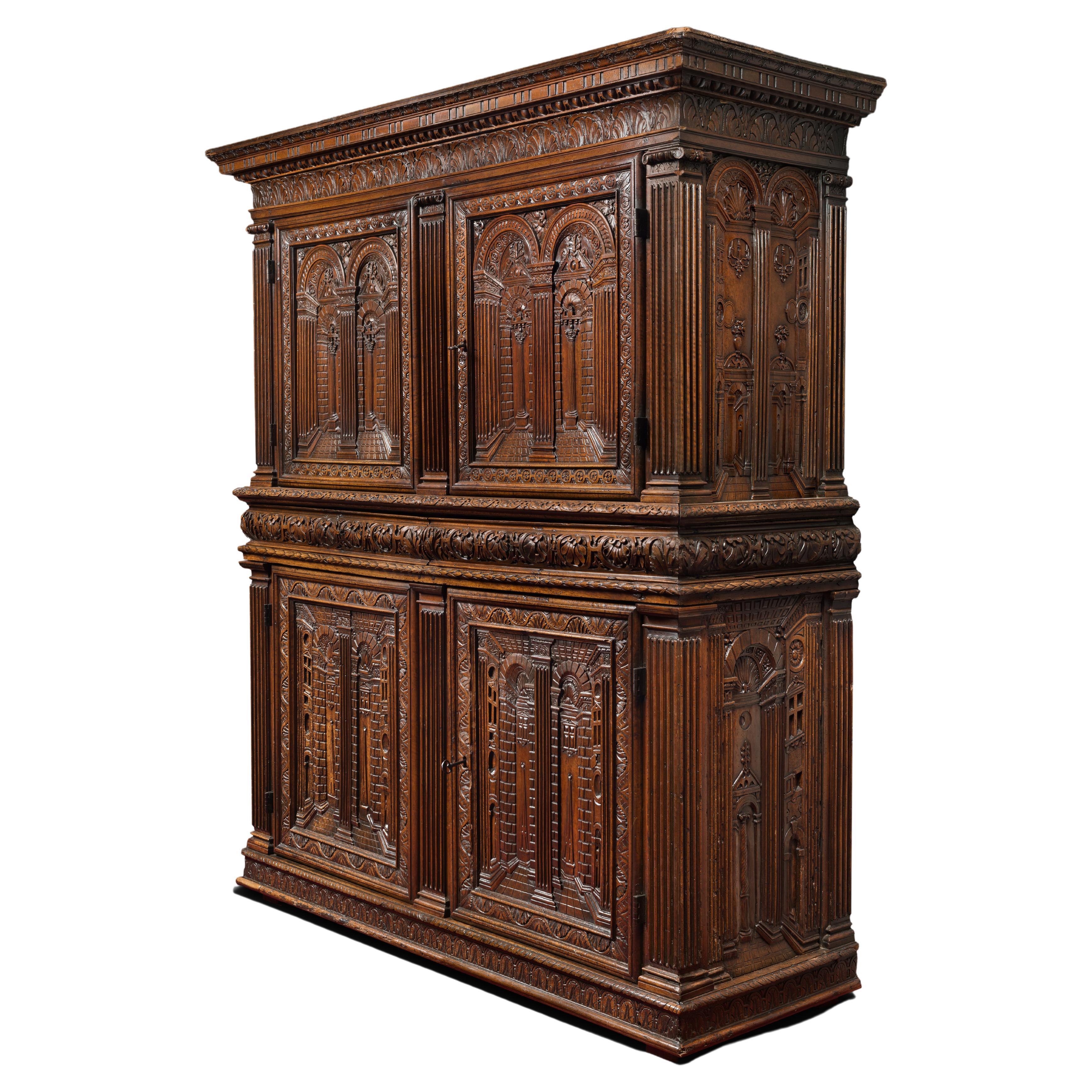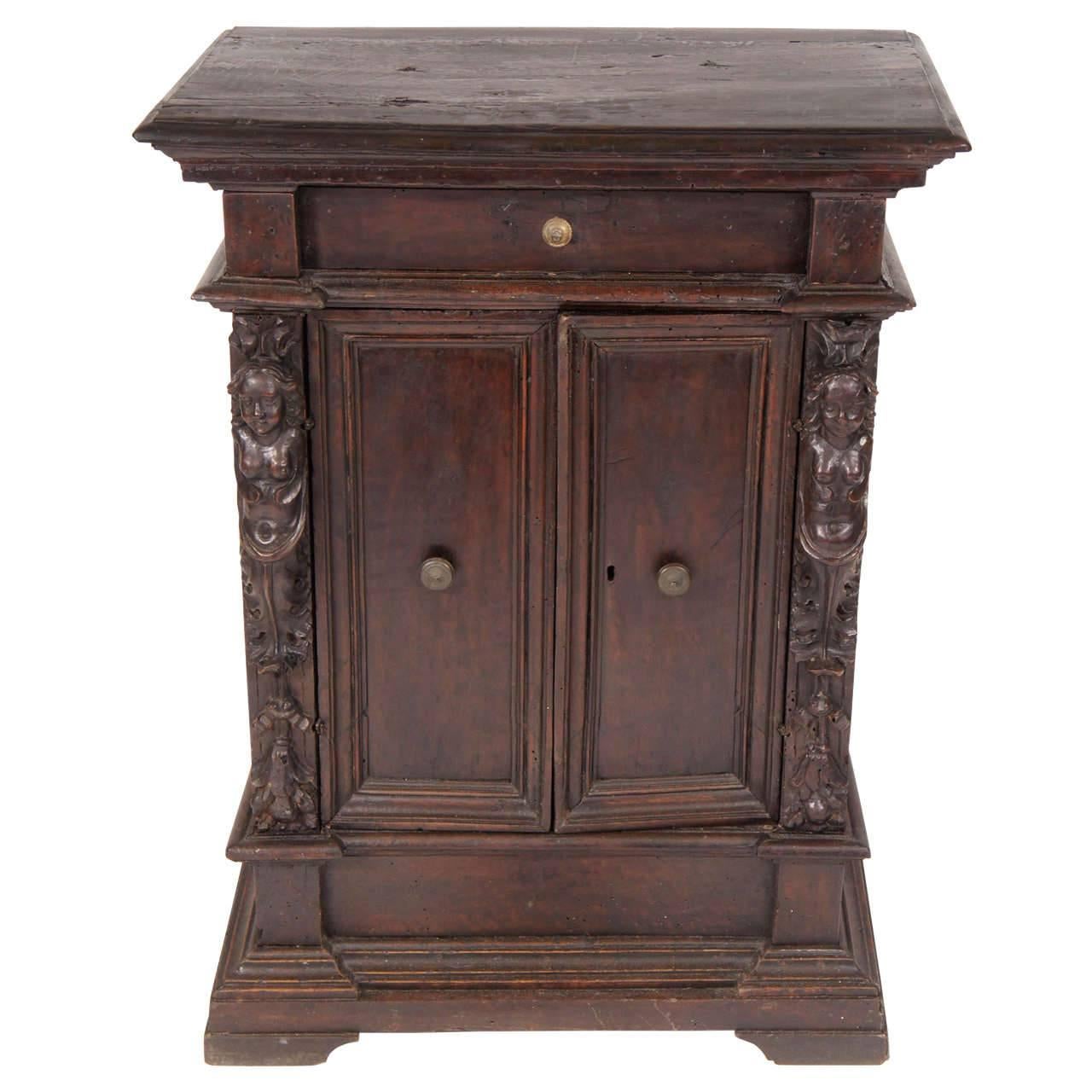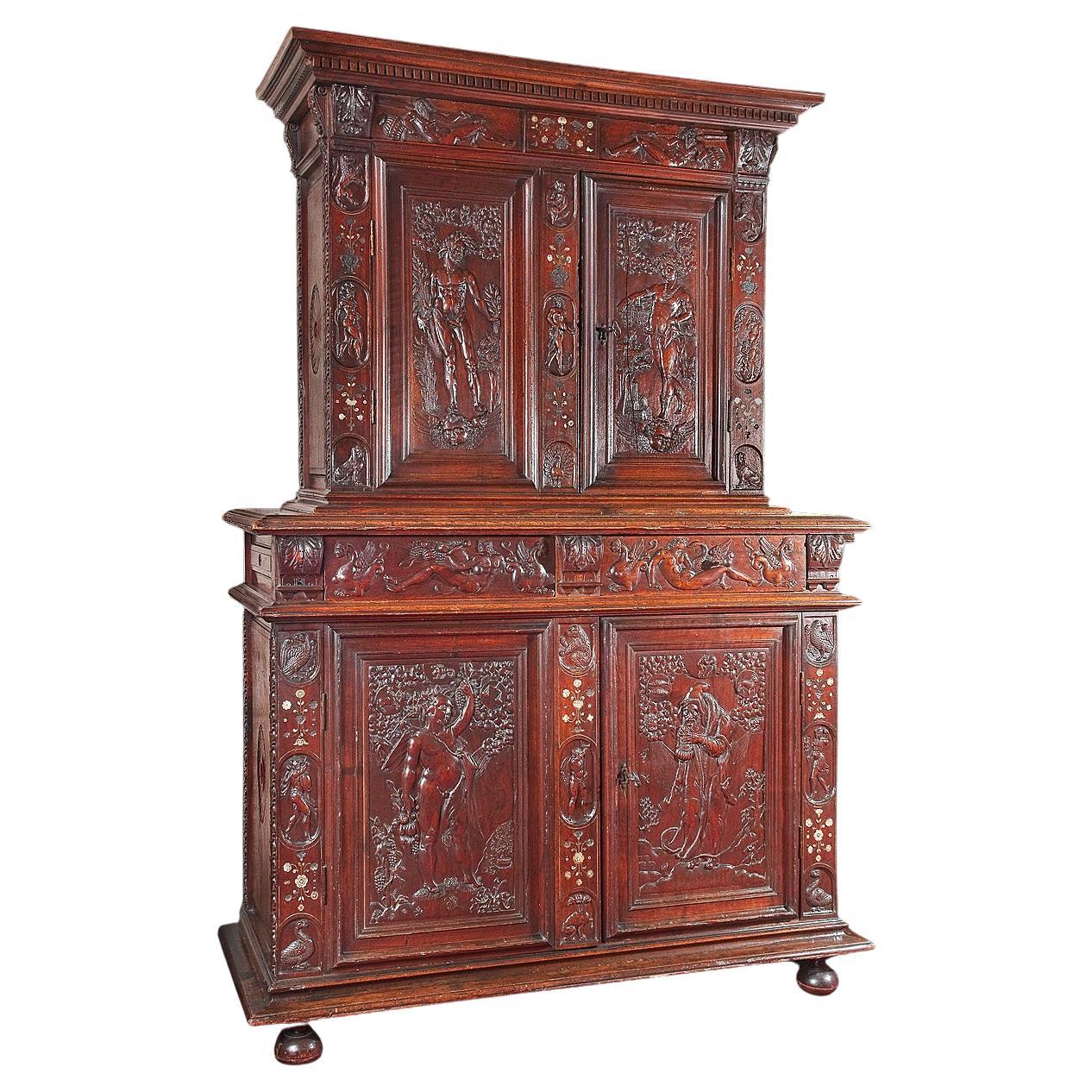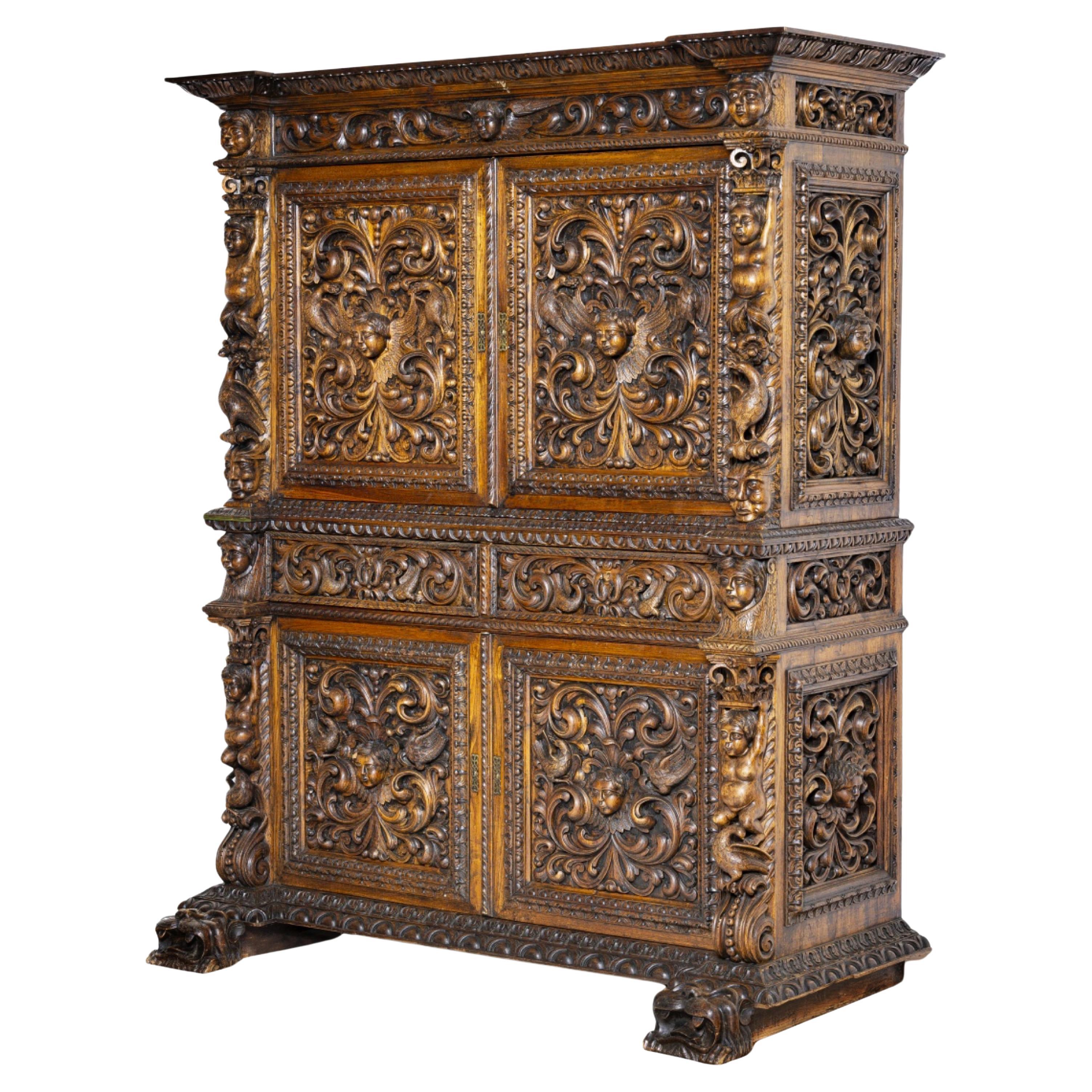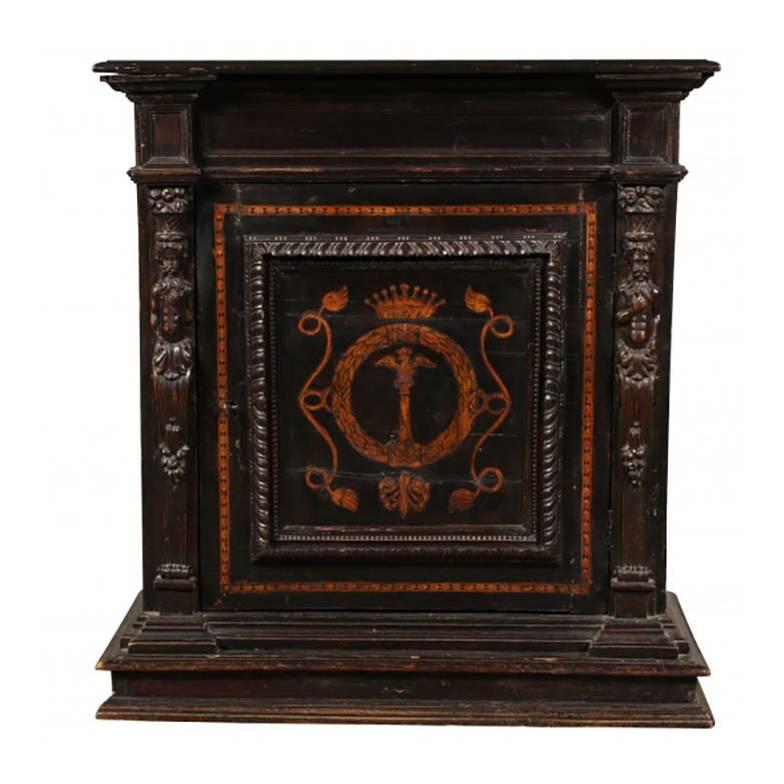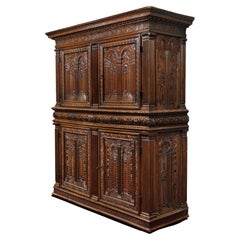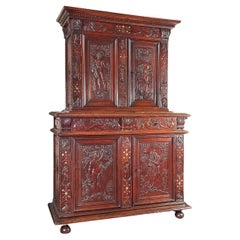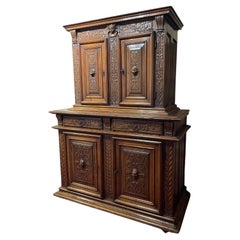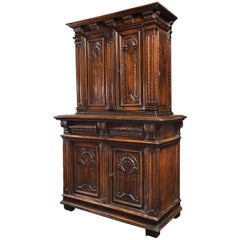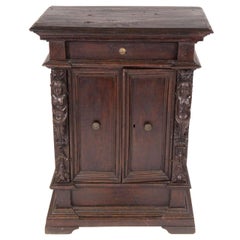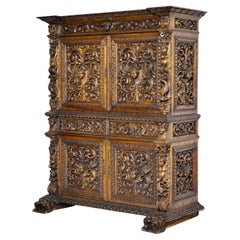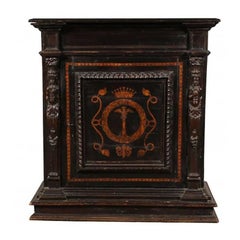Items Similar to Rare Renaissance Florentine Cabinet with Certosina Decoration
Want more images or videos?
Request additional images or videos from the seller
1 of 8
Rare Renaissance Florentine Cabinet with Certosina Decoration
$23,621.12
£17,783.09
€20,000
CA$32,539.65
A$36,442.35
CHF 19,015.02
MX$445,127.67
NOK 241,926.42
SEK 228,044.64
DKK 152,242.71
About the Item
RARE RENAISSANCE FLORENTINE WALNUT CABINET WITH CERTOSINA DECORATION
ORIGIN: FLORENCE, ITALY
PERIOD: END OF 15th CENTURY – BEGINNING OF 16th CENTURY
Height: 129 cm
Length: 107 cm
Depth: 50 cm
Walnut and veneer (cedar, ebony, maple, poplar)
This small cabinet with two doors in the front and a drawer is a synthesis of sculpture and marquetry, different techniques that were very popular during the Italian Renaissance.
Perfectly structured, it imitates the facades of ancient temples.
The two leaves are framed by two pilasters that rise from a slightly projecting moulded base. The base decorated with a rose window frames a long drawer. The pilasters are carved with plant motifs. Two capitals with acanthus baskets crown them and support a powerful entablature with a particularly overhanging cornice. A frieze of stars in marquetry is set between two beautiful flowers.
Each leaf is divided into two almost square panels surrounded by marquetry filleting depicting geometric motifs. The upper panels are decorated with fine scrolls forming interlaces while the two lower panels are carved with double corolla flowers.
A frieze of foliage symmetrically frames a coat of arms.
The small and elegant proportions of this cabinet, the vigour of its sculpture, the refinement of its marquetry along with its volumes make it a piece of furniture of great quality
HISTORIC
At the end of the 15th century, Florence was home to numerous marquetry and woodcarving workshops. The golden age of intarsia, the marquetry of wood, took place between 1470 and 1520.
During the 15th century, intarsia was limited to light, sober and sparingly distributed friezes. The end of the quattrocento witnesses a greater use of marquetry turning pieces of wood into real palatial pieces.
This furniture, isfoggiato, as opposed to the very regulated fogia furniture ( only one type of wood, cornice forbidden, board's uniform thickness ) was a real sumptuary expense requiring for their realization an authorization of the Arte dei Legnaioli and the payment of a tax.
Often compared stylistically to Middle Eastern craftsmanship, of which certain groups could be found in Venice or Florence, the origin of intarsia is to be found beyond that in the cosmatesque (stone mosaics). Both for its techniques and style, the work of the Cosmati marble makers and their successors, applied to church pavements and pieces such as wall facings or ambos, leads us to see intarsia as a true evolution and derivation of this craft. Moreover, it was common for some of the best wood markers, such as Domenico del Coro or Pietro del Minella, to be employed in the creation of church pavements.
Intarsia itself is divided into several varieties which differ in their processes as well as in their appearance.
On this cabinet predominates certosina ; a marquetry composed of tiny pieces of wood, most often in geometrical forms. The word certosina originates from the work produced by the carthusians. Disciples of Saint Bruno applied themselves for centuries to the patient making of wood or mother-of-pearl inlays, bone or ivory marqueteries, whose purpose was to enrich ecclesiastical furniture.
Certosina spread beyond the monastic order to reach Florentine workshops amongst others. When intarsia pittorica appeared, certosina did not fade away and kept being used on furniture as bands, friezes or cornices.
- Dimensions:Height: 50.79 in (129 cm)Width: 42.13 in (107 cm)Depth: 19.69 in (50 cm)
- Materials and Techniques:
- Period:
- Date of Manufacture:16th Century
- Condition:Repaired: Alterations and restoration to account for ater moldings and elements replacements. Wear consistent with age and use.
- Seller Location:Saint-Ouen, FR
- Reference Number:1stDibs: LU3115336040822
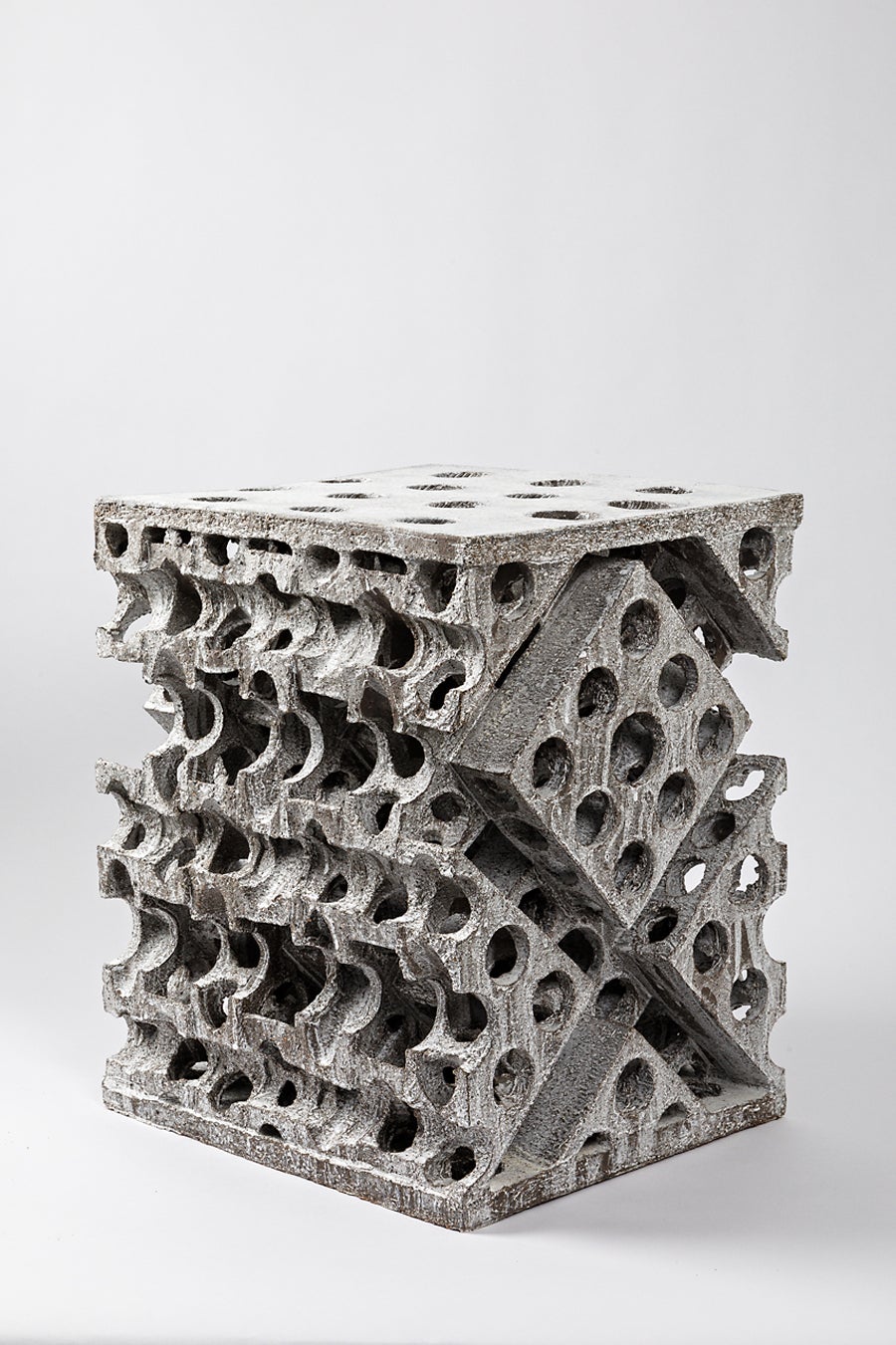
About the Seller
5.0
Vetted Professional Seller
Every seller passes strict standards for authenticity and reliability
Established in 2016
1stDibs seller since 2017
189 sales on 1stDibs
Typical response time: 1 hour
- ShippingRetrieving quote...Shipping from: Paris, France
- Return Policy
Authenticity Guarantee
In the unlikely event there’s an issue with an item’s authenticity, contact us within 1 year for a full refund. DetailsMoney-Back Guarantee
If your item is not as described, is damaged in transit, or does not arrive, contact us within 7 days for a full refund. Details24-Hour Cancellation
You have a 24-hour grace period in which to reconsider your purchase, with no questions asked.Vetted Professional Sellers
Our world-class sellers must adhere to strict standards for service and quality, maintaining the integrity of our listings.Price-Match Guarantee
If you find that a seller listed the same item for a lower price elsewhere, we’ll match it.Trusted Global Delivery
Our best-in-class carrier network provides specialized shipping options worldwide, including custom delivery.More From This Seller
View AllImportant Renaissance Cabinet from Lyon 'France' with a Decor of Perspectives
Located in Saint-Ouen, FR
As soon as 1540 France's second Renaissance is in the making, intimately linked to the rediscovery of the Antique world. The development of the printing and engraving industry allows the spread of artworks and models in many cities and countries. The Italian influence can be perceived in every artistic field. While the French king entrust the most talented Italian artists with major projects such as Il Rosso or Primaticcio in Fontainebleau, French artists also travel to Italy to form themselves to this new style. In Italy they get acquainted with the work of Leo Battista Alberti the first to theorize perspective (De Pictura, 1435-36) and architecture (De re oedificatoria, 1541). Those two publications would have a revolutionary impact on arts.
Furniture is marked by the work of the most famous Italian architects of the time as well as French architects. Indeed Philibert de l'Orme competes with Alberti and by the end of his life publishes several treaties including one devoted to a theory of architecture (1567). Unfortunately he would not live to complete the second volume. In this treaty he expresses his interest for mathematical norms applied to architecture, copied from the Antique. His journeys in Italy allowed him to accumulate the most sophisticated references. Jean Bullant, another architect of great talent also theorizes his practice. He establishes rules characterizing Greco-Roman art staying faithful to Vitruvius.
Following this new inspiration the structure of furniture evolves. From then on appear columns, capitals, cornices, friezes and architraves. The ornamentation uses this inspiration as well with egg-and-dart, palm leaf and rose adorning the most beautiful pieces.
In Lyon, crossroad where meet merchants from everywhere those new experiments are welcomed. Lyon florishing printing industry allows the spreading of models and treaties essential to the artist's work. Thus the first publication of Vitruvius' De Architectura in France would be printed in Lyon in 1532.
Artists from Lyon rediscover and familiarize themselves with the Antique knowledge very early. They adopt those new ideas and use them in their own creations. Lyon cabinet-makers re interpret Antique architecture and Italian Renaissance palaces to give their pieces a pure and harmonious architectural structure. Grooved pilasters are particularly favored. They are topped by capitals of diverse orders always respecting the sequencing with simpler ones for the lower levels and the richest ones on the higher levels. As for the ornamentation, one of the great distinctiveness of Lyon workshops remains the architectural perspective illusions, drawing inspiration from Tuscany.
True masterpiece of the Second French Renaissance this important cabinet illustrates Lyon workshops' taste for fine Italian architecture inspired by Antiquity. An architectural perspective of great quality is treated in symmetry on each panel.
This two-bodied cabinet without recess stands on four rectangular feet. The base comprises a molding, a palm leaf frieze and is bordered by a braid.
The lower body is divided by three grooved pilasters with Tuscan capitals framing two door-leaves. The two panels are encircled by a moudled frame with palm leaves. They are finely carved with a decor of fantasized architecture depicting an Italian Renaissance palace erected symmetrically on each side of a grooved pilaster. On the ground floor a door opens through a stilted arch while the stories are opened with mullioned windows, dormers and occuli. Two large pegged-boss cladded pillars support the entablature enriched by a palm leaf frieze upon which stands an arch whose coffered intrados is centred by a rose. Behind this arch a pyramid appears, standing in front of a second facade with a window topped by a broken curvilinear pediment under a cul-de-four with a shell.
The checker flooring gives depth to the low-reliefs creating vanishing points structuring the panels and guiding the eye of the observer.
A thin laurel braid highlights the belt of the cabinet where are located two drawers. Their facades are adorned by palm leaves in hoops.
The upper body is encircled with palm leaves. The same ternary division as in the lower body appears. However, the pilasters are topped by Ionic capitals with volutes and egg-and-dart. The door-leaves are framed with flowers. On the panels the artist has designed another architectural decor. On the foreground open two arches on top of grooved pilasters with rectangular capitals adorned with palm leaves. The arches are enriched with braids and the coffered intrados bears a decor of roses. The spandrels also bear a flower decor. In the background another arcature hosts a fluted grooved column topped with double basket acanthus capital, characteristic of Corinthian order. The triangular pediment is interrupted by a choux bourguignon.
A large cornice crowns the cabinet. It stands on pilasters and forms an entablature comprising a palm leaf frieze and an egg-and-dart, triglyph and palm leaf cornice.
The cabinet's sides have also been carefully considered. The lower body's panels are enriched with an arch rising above a broken pediment portico hosting a twisted column. Flowers garnish the spandrels. An architectural facade completes the decor. The upper body's panels present two arches supported by a facade opened with dormers and mullioned windows as well as cartouches (one bears the inscription 1580 dating the cabinet) suggesting the interior of an Italian Renaissance palace, confirmed by the chandeliers. The flooring leads our gaze to a second arch with a broken curvilinear pediment where stands a flower vase. This arch opens onto a perspective of another facade along a road.
Inside the cabinet, on the lower body door-leaves appear two designs. On the right door is depicted a Crucifixion. Saint Mary and Saint John flank the Christ on the cross. In the bottom part is inscribed « Dure uiator abis nihil haec spectacula curas / Pendenti cum sis unica cura Deo. / Tota suo moriente dolet natura Magistro. / Nil qui solus eras caussa dolenda doles. ». The signature [Christoff Swartz Monachiensis pinx[it] / Ioa[nnes] Sadeler sculp[it]] tells us it was made by Johan Sadeler I (1550-1600) after Christoph Schwartz (1548-1592). This engraving belongs to an ensemble depicting the Passion of Christ Johan Sadeler executed in 1589 after an altar piece painted by Christoph Schwartz for the private chapel of Renée of Loraine, wife of Duke William V of Bavaria. This altar piece made of nine copper panels has been destroyed during the 19th century. The Crucifixion panel once in the centre of the altar piece is the only one that survived and is today kept in Munich's Alte Pinakothek.
On the left door appears Saint Francis receiving the stigmata. The inscription says : « Signastidomine Servum Tuum. Franciscum. Signis Redemptionis Nostrae ».
This Renaissance cabinet with an architectural decor appearing as much in the structure faithful to Antique rules...
Category
Antique 16th Century European Renaissance Cabinets
Materials
Walnut
Rare Renaissance Cabinet Richly Carved
Located in Saint-Ouen, FR
This rare Renaissance cabinet is richly decorated on the doors and drawers with carvings depicting the four seasons, and on the uprights and the entablature, alternating flower bouquets inlaid with mother of pearl. This is a beautifully conceived piece of furniture, representing a crowned portico with its entablature and cornice.
The upper body
Articulated separately in a ternary rhythm, as with the lower body, the upper part opens with two carved doors. The doors are framed by both the lateral uprights and the casing. There are cartouches carved into the casing in which mythological figures are depicted with flower bouquets.
On the doors:
On the right: Spring, a female figure crowned with a wreath of leaves, holding a basket full of flowers. She is wearing necklaces and bracelets on each arm, with drapery discretely wrapped around her body and is standing on a winged putti’s head. On each side are depicted a tree and a village with a steepled church. Above her head floats the three signs of the zodiac corresponding to the season: Aries, Taurus and Gemini.
On the left: Summer, a bearded man crowned with ears of corn and bearing armfuls of corn. He is standing on a similar winged putti, flanked by a tree and an ear of corn. The following three signs of the zodiac appear: Cancer, Leo and Virgo.
On the uprights and the central casing a number of smaller figures seem to represent virtues and vices that newly wedded couples should aspire to and avoid.
On each side, at the bottom of the uprights, there is a dog representing fidelity. Above, a lion embodies power, wisdom, and justice.
In between, on the left upright, there is a figure of noncombatant Athena wearing a helmet and holding a spear, an arrow pointing down and in her left hand, a shield, symbol of protective power. On the right upright, the goddess Venus controls the arrow of Cupid.
The iconography here acts as a clear reminder of the required virtues that both parts of a young couple need to fulfill: fidelity, power, wisdom and justice. For him, the goddess Athena focuses on the power. Whereas for her, it is Venus who shows how to control Cupid’s arrow.
On the central casing at the bottom, by way of contrast, there is a peacock, a symbol of pride and at the top, a monkey representing lust and mischief. In between, a woman holding a chain and a cup full of precious stones while on the floor sits a half empty opened casket. This can be interpreted as a symbol of extravagance.
Above, the entablature, decorated with male figures resting on leaking urns, may symbolize the passing of time. They are flanked by two consoles decorated with acanthus leaves and separated by flower bouquets (inlaid with mother of pearl). Finally on top, a cornice acts as a crown for the piece of furniture.
The lower body
The moulded base stands on four round, flattened feet.
Represented on the doors:
On the left: Autumn, a stocky, naked man crowned with vine leaves, holding fruits in his right hand and with his left, picking a bunch of grapes from a climbing vine. Standing on a mound, he is surrounded by a vine and a hill, at the foot of which a man presses the grapes in a big vat after the harvest. Above the climbing vine appear the signs of Libra, Scorpio and Sagittarius.
On the right: Winter, an elderly man wearing a fur cloak...
Category
Antique 16th Century French Renaissance Cabinets
Materials
Walnut
Small Renaissance Cabinet
Located in Saint-Ouen, FR
Small renaissance cabinet
ORIGIN : FRANCE
PERIOD : END OF THE 16th CENTURY
Measures: height: 167 cm
length: 123 cm
depth: 58 cm
This small two-part unit with harmonious proportions opens with four front leaves and two belt drawers. It rests on a molded base.
The uprights and the central frame of the lower body are adorned with long stylized palmettes. They frame the four leaves on which unfolds a vegetal decoration made of stems and leaves sculpted in symmetry around two mascarons topped with feathers...
Category
Antique 16th Century French Renaissance Cabinets
Materials
Walnut
$17,715
French Renaissance Cabinet with Perspectives
Located in Saint-Ouen, FR
This Renaissance Cabinet reveals the great mastery of the Lyon workshops which are at the origin of its realization. Sculptors and wood-carvers worked here in symbiosis to express an...
Category
Antique 16th Century French Renaissance Cabinets
Materials
Walnut
16th Century French Carved Renaissance Cabinet
Located in Saint-Ouen, FR
Rare carved Renaissance cabinet
Period : 2nd half 16th century, ca. 1570
Origin : France, Burgundy or Languedoc
This cabinet embody the produ...
Category
Antique 16th Century French Renaissance Cabinets
Materials
Walnut
Renaissance Cabinet form Lyon 'France'
Located in Saint-Ouen, FR
Condition : Partly dating from the Renaissance. The backs and the drawer’s insides have been re-done.
Historical background
The 16th century is a prosperous period for Lyon...
Category
Antique 16th Century French Renaissance Cabinets
Materials
Walnut
You May Also Like
Italian Renaissance Style Cabinet
Located in Sheffield, MA
Small in size but impressive in the scale of its architectural moldings and details, this Italian Renaissance-style cabinet contains two shelves b...
Category
Antique 19th Century Italian Jacobean Cabinets
Italian Renaissance Style Cabinet
Located in Sheffield, MA
Small in size but impressive in the scale of its architectural moldings and details, this Italian Renaissance-style cabinet contains two shelves behind double paneled doors and a cen...
Category
Antique 19th Century Italian Jacobean Cabinets
RENAISSANCE TWO BODY CABINET 19th Century
Located in Madrid, ES
RENAISSANCE TWO BODY CABINET 19th Century
In oak wood
Upper part with two profusely carved doors.
Lower part with two drawers and two doors.
Decorated with plant motifs, zoomorphic ...
Category
Antique 19th Century Portuguese Baroque Cabinets
Materials
Wood
Late 19th Century Renaissance Style Carved Cabinet
Located in Bridgeport, CT
Antique carved cabinet having a central marquetry inlaid door panel with high relief carved rope design flanked by carved figural columns, panel...
Category
Antique Late 19th Century Renaissance Cabinets
Materials
Wood
Neo-Renaissance Cabinet, Late 19th Century
Located in Greding, DE
A four-door cabinet in Renaissance style standing on ball feet with lion's head mascarons and half-columns with volute capitals. The doors with panels and vine decoration are separat...
Category
Antique 19th Century German Renaissance Revival Cabinets
Materials
Wood
French 17th Century Cabinet
Located in Stockbridge, GA
What a wonderful piece, full of character with the ornaments at the base and the putties carved in the wood.
Category
Antique Late 17th Century French Renaissance Cabinets
Materials
Oak, Walnut
More Ways To Browse
Used Casement Window
Ecclesiastical Furniture
Renaissance Pearl
16th Century Stone
Italian Renaissance Light
Used Casement Windows
Italian Renaissance Cabinet
Renaissance Cabinet Italy
Antique Casement Windows
Italian Renaissance Doors
Cabinet In Cedar
Florentine Light
Italian Renaissance 15th Century
Antique Italian Florentine Frame
Antique Ivory Cabinets
Florentine Sculpture
Ebony Carved Cabinet
Florentine Scroll
